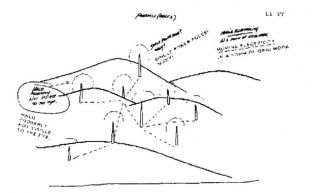
Parapsychology
The Psychic Espionage You Paid For
We sit down with Edwin May, head researcher of the former Stargate program
Posted December 12, 2012
By Berit Brogaard and Kristian Marlow
Do you believe in extrasensory perception? Are you aware that until recently the U.S. government did? Codenamed “Stargate,” the highly classified ESP espionage program ran until 1995. The government became interested in this type of research during the Cold War after hearing rumors that the Russians already had an application program already on the topic. We recently sat down with Edwin May, the former head of parapsychological research for the Stargate Project, to talk about what it's like to study psychic phenomena.
How did you become involved in ESP research?

Parapsychologist Edwin May
I earned my Ph.D. in Nuclear Physics. At that time I had no idea that people were researching extra sensory perception and, had I known, I would have rejected it out of hand like most people do. I saw a very strange guy (now dead) by the name of Robert Monroe, who talked about something I had never heard of before called an “out of body experience.” He looked like a banker, about 50 years old. I thought “Well, if that banker can do it—I’m a physicist—I should be able to do it.” So I bought his book and read it. Of course, nothing happened and I immediately rejected it as silly. A year later, Charles Honorton gave a talk at Berkeley and I went to hear him and, my god, he was talking good science. I invited him out for dinner and really put the screws to him with hard questions and had good answers for every one of them. To make a very long story short, I spent a year in India chasing after miracles—found none. When I came back, I ran into Ingus Swan who then was working for a highly classified program at the Stanford Research Institute (SRI). He hired me first as a consultant in 1975 and joined the staff as a physicist a year later.
What was it like working for SRI?
At that time, we were funded by the CIA and then later the Foreign Technology Division of the Air Force. By 1985 I became the director of this substantial program. We ended up having $22 million over 20 years, which in government funding world is nothing but peanuts, but in the parapsychology world is more than the totality of the field’s funding up to date. That enabled us to hire the best people for the job. If we wanted to do some subliminal experiment, we could hire a guy who had gotten an award in science for his work in subliminal perception. Government funding was extremely helpful and helped us make remarkable progress.
What does your research tell us?
There’s incontrovertible evidence for a statistically based information transfer anomaly we currently do not understand. Even some of the critics in the field agree with that very much. That statement is totally different than saying, “I believe in ESP.” For example, pretend somebody you don’t know has a card in his pocket and on that card are geographical codes. If I then ask someone who doesn’t know the person to tell me about the site those geographical codes point to, oddly enough, many are likely to get it right, enough to be very, very interesting.
Tell me about one of the more interesting studies you did.

A drawing of a target produced by a Stargate psychic
There was a class of targets that we never missed: underground nuclear explosions in Russia, China or the USA. Electromagnetic pulse devices and things like that. One might guess that people picked up on a huge burst of energy, but since we were dealing with precognition, the subject would have to perform some sort of clever seismic feet because they were telling us about the blast before the blast went off. The lucky guess I made was that it’s not energy increase out in a very short period of time but the thermal genomic entropy. Something goes from static to a very chaotic state very fast. And we never missed those. I tried to see if we could test the psychics’ abilities in laboratory conditions. We found that there is a significant and persistent correlation between the quality of remote viewing and the gradient of Shannon entropy.
Can you explain Shannon entropy?
Entropy itself is the logarithmic average over probabilities. Shannon entropy is the quantification of the expected value of the information contained in a message. For example, take a 800 by 600 pixel picture and divide it into little patches. If you calculate a color probability for the color in each square, you can define the entropy for each square. If you add up all of these, you can form a two-dimensional map of the color’s arrangement in the photograph. This data can then further be crunched into a compressed representation that contain the same information, requiring a much shorter description than would a description of each patch. This is called information theory and is the basic idea behind data compression on computerized devices. A photograph consisting of one solid color is barely entropic because it can be represented by a description of its dimensions and one color. But a photograph depicting vivid imagery is highly entropic because it requires a much more complicated representation that encompasses many difference colors in many different locations. This is not cognitive information; this analysis does not care whether it’s a daisy or a nuclear explosion. It’s just a big intensity analysis. What surprised me, we did a number of experiments and all of a sudden the more special information there is on the picture the better the remote viewing. That’s bizarre!
Have any areas of ESP research hit a dead end?
Research on psychokinesis (moving object with the mind) hasn’t demonstrated anything. The army wanted me to do missile trials, knock Soviet missiles out of the sky with the mind. We didn’t even get close.
What do you think you research tells us about spirituality?
I’m a really hard nosed, materialist, reductionist atheist. I think consciousness is emergent property of the wetware. So I’m more interested in two aspects of this phenomenon: (1) how does the information get there and (2) how does the central nervous system process the detected information?

